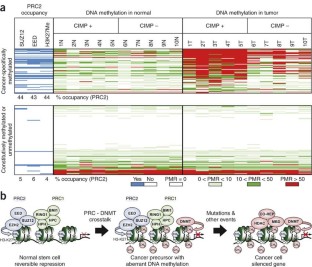Epigenetic stem cell signature in cancer (original) (raw)
- Brief Communication
- Published: 31 December 2006
- Heidi Fiegl1,2,
- Daniel Egle2,
- Elisabeth Mueller-Holzner2,
- Gilbert Spizzo3,
- Christian Marth2,
- Daniel J Weisenberger4,
- Mihaela Campan4,
- Joanne Young5,
- Ian Jacobs1 &
- …
- Peter W Laird4
Nature Genetics volume 39, pages 157–158 (2007)Cite this article
- 9305 Accesses
- 839 Citations
- 26 Altmetric
- Metrics details
Abstract
Embryonic stem cells rely on Polycomb group proteins to reversibly repress genes required for differentiation. We report that stem cell Polycomb group targets are up to 12-fold more likely to have cancer-specific promoter DNA hypermethylation than non-targets, supporting a stem cell origin of cancer in which reversible gene repression is replaced by permanent silencing, locking the cell into a perpetual state of self-renewal and thereby predisposing to subsequent malignant transformation.
This is a preview of subscription content, access via your institution
Access options
Subscribe to this journal
Receive 12 print issues and online access
$209.00 per year
only $17.42 per issue
Buy this article
- Purchase on SpringerLink
- Instant access to full article PDF
Prices may be subject to local taxes which are calculated during checkout
Additional access options:
Figure 1: PRC2 promoter occupancy in human ES cells and DNA methylation in human colorectal tumors and matched normal mucosa.

Similar content being viewed by others
References
- Houghton, J., Morozov, A., Smirnova, I. & Wang, T.C. Semin. Cancer Biol. published online 4 May 2006 (doi:10.1016/j.semcancer.2006.04.003).
- Passegue, E. Nature 442, 754–755 (2006).
Article CAS PubMed Google Scholar - Pardal, R., Clarke, M.F. & Morrison, S.J. Nat. Rev. Cancer 3, 895–902 (2003).
Article CAS PubMed Google Scholar - Jordan, C.T., Guzman, M.L. & Noble, M. N. Engl. J. Med. 355, 1253–1261 (2006).
Article CAS PubMed Google Scholar - Ringrose, L. & Paro, R. Annu. Rev. Genet. 38, 413–443 (2004).
Article CAS PubMed Google Scholar - Schuebel, K., Chen, W. & Baylin, S.B. Nat. Genet. 38, 738–740 (2006).
Article CAS PubMed Google Scholar - Lee, T.I. et al. Cell 125, 301–313 (2006).
Article CAS PubMed PubMed Central Google Scholar - Weisenberger, D.J. et al. Nat. Genet. 38, 787–793 (2006).
Article CAS PubMed Google Scholar - Hatada, I. et al. Oncogene 25, 3059–3064 (2006).
Article CAS PubMed Google Scholar - Squazzo, S.L. et al. Genome Res. 16, 890–900 (2006).
Article CAS PubMed PubMed Central Google Scholar - Bracken, A.P., Dietrich, N., Pasini, D., Hansen, K.H. & Helin, K. Genes Dev. 20, 1123–1136 (2006).
Article CAS PubMed PubMed Central Google Scholar - Feinberg, A.P., Ohlsson, R. & Henikoff, S. Nat. Rev. Genet. 7, 21–33 (2006).
Article CAS PubMed Google Scholar - Eads, C.A. et al. Cancer Res. 60, 5021–5026 (2000).
CAS PubMed Google Scholar - Shen, L. et al. J. Natl. Cancer Inst. 97, 1330–1338 (2005).
Article CAS PubMed Google Scholar - Roy, N.S. et al. Nat. Med. 12, 1259–1268 (2006).
Article CAS PubMed Google Scholar
Acknowledgements
The work described in this manuscript was supported by grants from the European Union (FP6-016467; Biognosis) and from the FWF Austrian Science Fund (L69-B05) awarded to M.W. and by US National Institutes of Health grant R01 CA075090 awarded to P.W.L.
Author information
Authors and Affiliations
- Department of Gynecological Oncology, Institute for Women's Health, University College London, London, WC1E 6DH, UK
Martin Widschwendter, Heidi Fiegl & Ian Jacobs - Department of Obstetrics and Gynecology, Innsbruck Medical University, Innsbruck, Austria
Heidi Fiegl, Daniel Egle, Elisabeth Mueller-Holzner & Christian Marth - Department of Internal Medicine, Innsbruck Medical University, Innsbruck, Austria
Gilbert Spizzo - Departments of Surgery and of Biochemistry and Molecular Biology, University of Southern California/Norris Comprehensive Cancer Center, Los Angeles, California, USA
Daniel J Weisenberger, Mihaela Campan & Peter W Laird - Molecular Cancer Epidemiology Laboratory, Queensland Institute for Medical Research, Herston, 4006, Australia
Joanne Young
Authors
- Martin Widschwendter
You can also search for this author inPubMed Google Scholar - Heidi Fiegl
You can also search for this author inPubMed Google Scholar - Daniel Egle
You can also search for this author inPubMed Google Scholar - Elisabeth Mueller-Holzner
You can also search for this author inPubMed Google Scholar - Gilbert Spizzo
You can also search for this author inPubMed Google Scholar - Christian Marth
You can also search for this author inPubMed Google Scholar - Daniel J Weisenberger
You can also search for this author inPubMed Google Scholar - Mihaela Campan
You can also search for this author inPubMed Google Scholar - Joanne Young
You can also search for this author inPubMed Google Scholar - Ian Jacobs
You can also search for this author inPubMed Google Scholar - Peter W Laird
You can also search for this author inPubMed Google Scholar
Contributions
E.M.-H. and C.M. provided tissue samples. D.E. and G.S. contributed to the hematopoietic stem cell work. H.F., D.J.W. and M.C. performed MethyLight analyses and provided MethyLight reaction details. J.Y. and I.J. provided logistical and intellectual support. M.W. and P.W.L. analyzed the association between PRC2 occupancy and cancer-specific DNA methylation and jointly wrote the manuscript.
Corresponding authors
Correspondence toMartin Widschwendter or Peter W Laird.
Ethics declarations
Competing interests
P.W.L. is a shareholder, consultant and scientific advisory board member of Epigenomics, AG, which has a commercial interest in DNA methylation markers. This work was not supported by Epigenomics, AG.
Supplementary information
Rights and permissions
About this article
Cite this article
Widschwendter, M., Fiegl, H., Egle, D. et al. Epigenetic stem cell signature in cancer.Nat Genet 39, 157–158 (2007). https://doi.org/10.1038/ng1941
- Received: 22 August 2006
- Accepted: 16 November 2006
- Published: 31 December 2006
- Issue Date: 01 February 2007
- DOI: https://doi.org/10.1038/ng1941